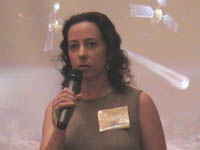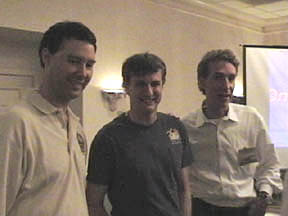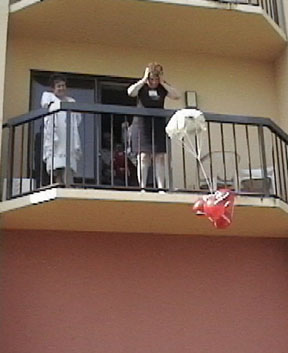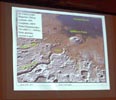What's New
Our
Team
Our
Friends
Interviews
Activities
Resources
Ask
Experts
Our
Mission
|
|
The Perfect
Opportunity Arises
Two
days of all-out Mars!
by Stephanie Wong
with
contributions from Bonnie Walters and Michelle Mock
Imagiverse
team members Michelle Mock, Stephanie Wong and Bonnie
Walters vacationed the only way that Mars educators know
how to -- they went to a Mars educator workshop.
More precisely, they went to the Roving the Red Planet
Mars Exploration Rover Workshop in Florida, sponsored by
Arizona State University, the Jet Propulsion Laboratory,
Cornell University and NASA.
Why go
to a Mars workshop? To learn about the planet we humans
are exploring, to bring the excitement of Mars
exploration to the classroom, and of course, to meet the real
rock stars! It was a spectacular two days, brimming
with activities and presentations by members of the
scientific, engineering and pedagogical community.
Coinciding
with the scheduled launch of MER-B, the workshop was a
two-day affair in Cocoa Beach, hosted by ASU Mars K-12
Outreach Program Coordinator Sheri Klug,
designed to instruct and inspire educators on the Mars
Exploration Rover (MER) mission. It began bright
and early one hot and muggy day in the Enterprise
ballroom, when educators of all sorts began filing into
the room. Michelle and Bonnie (and especially
Michelle) were veterans of such Mars workshops, but this
was my first workshop. I had heard of the ASU
workshops before, about the field trips they had and
about the Mars Odyssey launch workshop in April 2001, so
I knew this one would be memorable. I did not
recognize any of the teachers, although there were a few
individuals about the room who were of NASA fame.
The Mars mission team was right there!
 Sheri introduced the
first speakers, Orlando Figueroa and Firouz Naderi,
Director of the Mars Exploration Program Office at NASA
HQ and Manager of the Mars Program Office at JPL,
respectively. Then, Mars scientist Jim Garvin gave
the first scientific presentation about the planet's
geology. Mars is a planet of extremes.
Earth's giant landforms are dwarfed by what is seen on
Mars. For example, as Jim noted, Mars has Hellas
Basin, the largest "hole" in the solar system.
This basin is a huge impact crater with a diameter of
2000 km and a depth of 7 km! He described several
features on the surface as seen from the Mars Orbiter
Camera onboard the Mars Global Surveyor (MGS) spacecraft,
an orbiter that has transformed our view of the planet. Sheri introduced the
first speakers, Orlando Figueroa and Firouz Naderi,
Director of the Mars Exploration Program Office at NASA
HQ and Manager of the Mars Program Office at JPL,
respectively. Then, Mars scientist Jim Garvin gave
the first scientific presentation about the planet's
geology. Mars is a planet of extremes.
Earth's giant landforms are dwarfed by what is seen on
Mars. For example, as Jim noted, Mars has Hellas
Basin, the largest "hole" in the solar system.
This basin is a huge impact crater with a diameter of
2000 km and a depth of 7 km! He described several
features on the surface as seen from the Mars Orbiter
Camera onboard the Mars Global Surveyor (MGS) spacecraft,
an orbiter that has transformed our view of the planet.
 Another scientist, Cathy
Weitz, gave the educators an overview of NASA's missions
to Mars. She covered, in detail, the Mars
Exploration science strategy to "search for water".
She ended her talk with the four 2007 Scout missions to
be selected in August. On August 4th, it was
announced that the "Phoenix" lander
had been chosen. Another scientist, Cathy
Weitz, gave the educators an overview of NASA's missions
to Mars. She covered, in detail, the Mars
Exploration science strategy to "search for water".
She ended her talk with the four 2007 Scout missions to
be selected in August. On August 4th, it was
announced that the "Phoenix" lander
had been chosen.
Steve
Squyres, the Principal Investigator for the Athena
Science Payload, gave the audience a special treat by
showing us the new HDTV version of Dan
Maas' MER mission animation.
This animation, depicting the launch, cruise, landing and
surface operations of the rovers, is a detailed piece of
scientifically-accurate graphics work. It awed the
crowd as the lander airbags bounced in tandem to the timpani from Holst's "The Planets: Mars". Now that
was a dramatic Mars movie.
 Planetary scientist Jim
Bell and well-known "Science Guy", Bill Nye,
went into detail about the sundials that are mounted on
the rovers. Originally, the coloured platforms were
only to serve the purpose of being a colour calibrator
for the Pancam, but Bill came up with the idea of adding
a knobbed stick in the middle of it to track the position
of the sun. A little model of that sundial and some
other unique specimens were on display. The word,
"Mars", was written in 17 languages on the
outside of the dial. Bill had an acronym -- PBJ
"passion, beauty and joy" -- which he thought
was what planetary science could instill in children. Planetary scientist Jim
Bell and well-known "Science Guy", Bill Nye,
went into detail about the sundials that are mounted on
the rovers. Originally, the coloured platforms were
only to serve the purpose of being a colour calibrator
for the Pancam, but Bill came up with the idea of adding
a knobbed stick in the middle of it to track the position
of the sun. A little model of that sundial and some
other unique specimens were on display. The word,
"Mars", was written in 17 languages on the
outside of the dial. Bill had an acronym -- PBJ
"passion, beauty and joy" -- which he thought
was what planetary science could instill in children.
Even
the lunches were well-spent. At each table was at
least one Mars expert. Between munches, the
educators wrote up brief biographies of their expert and
presented them to everyone else. At our table was
Dick Morris, a planetary scientist at the Johnson Space
Center in Houston. Michelle questioned him and
compiled a list of facts which Bonnie used to introduce
him. Dick is co-investigator of the Mössbauer
Spectrometer on Mars Express, the MER Athena Science
Payload, and the Mars Reconnaissance Orbiter, among other
things.
Classroom
Activities
Interspersed
between the scientific presentations were hands-on
classroom activities along with other education-related
Mars material. Many of the activities were
fun, provoking one's mind into thinking like an
engineer or scientist:
"Marsbound"–
Given a certain budget for a Mars mission, each
group of 4 or 5 had to choose which mission,
methods and scientific instruments to use from a
deck of marked cards. Each card had a
dollar amount assigned. The requirement was
to decide all of the above AND stay within budget.
It would be a very good activity for future
scientists, engineers and managers to work
together to achieve both science and engineering
goals while staying within budget. Although
reducing the mission planning process to a set of
playing cards, this game wasn't an easy task.
My team thought a bit too "big", going
for a rover rather than an orbiter, and went $100
million overbudget, and not to mention, having a
booster failure.
"Astronomy
with a Stick" - Here was a
wonderful way to bring indirect observations of
the Sun and seasons into the classroom at the
elementary level. Sundials come in all
shapes and forms. They can even be placed
on walls. While sundials can be as wacky as
imaginable, the educators made a simple version
out of card stock and straws.
"Rover
Quest" - In this activity we were
given 5 photos of essentially the same landscape
from various angles and distances. A
picture may be worth a 1000 words, but it doesn't
tell you much about depth. Given various
pictures of a landscape, can you tell which one
gives a closer view than the other? We were
to put the pictures in order from farthest to
nearest. Because a plain landscape, such as
Mars, has no identifiable markers, it is
difficult to tell how far things really are.
With a 1-D image, a small rock close-up may look
like a large boulder off in the distance, so how
is our depth perception? How can we tell
for sure? And given that we can tell, which
would be the best site to visit? And that
was the crux of the matter at hand. The two
teams at my table were singled-out since both of
our groups independently chose the image no other
group chose. While the other images had
large interesting features like hills and cliffs,
we went for the more subtle features, such as the
coloured deposits on what appeared to be a flat
floodplain. It was very gratifying to give
our rationale to the others.
"The
Egg-Drop Experiment" - The airbag
landing method, proven by Mars Pathfinder, and
adopted by MER, was approximated by balloons,
cardboard, string, tape and newspaper.  It was
a primitive, yet effective demonstration of
keeping small objects, like an egg, from being
damaged from a 2-storey drop. A tetrahedron
box was created from card stock in which an egg
was placed. Four balloons were attached to
the sides, and a string tether attached the
contraption to some newspaper parachutes.
And as if a bunch of Mars-crazed teachers weren't
spectacle enough, they all filed up to the second
floor of a hotel, and proceeded to drop the
"landers" from the balcony, right in
front of the lobby. The experiment was
successful, except for the team who "pre-broke"
their egg. It was
a primitive, yet effective demonstration of
keeping small objects, like an egg, from being
damaged from a 2-storey drop. A tetrahedron
box was created from card stock in which an egg
was placed. Four balloons were attached to
the sides, and a string tether attached the
contraption to some newspaper parachutes.
And as if a bunch of Mars-crazed teachers weren't
spectacle enough, they all filed up to the second
floor of a hotel, and proceeded to drop the
"landers" from the balcony, right in
front of the lobby. The experiment was
successful, except for the team who "pre-broke"
their egg.
"Radial
Model of the Solar System" - This
model provided an easy way to visualize planetary
orbits with some string. Make an apparatus
that can be a pivot (a nail in the ground would
be enough. Attach different coloured yarn
of scale radius to the planets' orbits. The
angles of the planets with respect to each other
orbiting the "sun" can be easily found
out via the web or an astronomy almanac.
The educators were once again outside in front of
the lobby playing around. As they held the
strings and moved about the sun pivot, they
learned about oppositions, conjunctions and what
time of day a planet would rise in their
planetary sky. I suggest doing an outer
planet model by adding an extra pivot for the
orbit of Pluto. With two axes and the
proper scaling, one can simulate the elliptical
orbit as it passes the orbit of Neptune.
"Mars
Landing Site Activity" - The
educators were given a large orbital view of a
region of Mars. They were asked to decide
whether there would be a good area to land.
The tricky part is finding a place that would fit
a landing ellipse. After all, the bouncing
Mars lander cannot make a pinpoint landing and
needs a fairly large area that's safe all around.
"Sun
Tracking Hemisphere Kit" - This
activity was to introduce the Sun's motion across
the sky to elementary school students.
Using a plastic hemisphere over a cross-haired
cardboard sheet and marking the position of the
sun on the sphere every few minutes, one can
track the motion of the sun over a day.
Doing the same experiment a few weeks later, it
can be seen that the sun traces out a different
path in the sky.
Mars Student
Imaging Project
http://msip.asu.edu/
Astronomy with a
Stick
http://www.nsta.org/awsday/
|
Ray Arvidson, John Grant
and John Callas talked about the engineering aspects of
the mission, such as mission operations, rover
technology, the search for the right landing site, and
the technique for landing on Mars.
There
were detailed presentations about the final landing site
selections for the rovers. The two major proponents
of the winning landing sites were Nathalie Cabrol and
Phil Christensen, individuals who were passionately
enthusiastic about exploring the planet.
 Nathalie supported
Gusev, a 3.9 billion year old crater in the southern
hemisphere near the equator. There is evidence that
the crater was once a lake, this furthered by a channel (Ma'adim
Vallis) flowing into it. There might be a rich
layer of sediment up to 10 m deep in this region.
An ideal site for the search for water and layered
deposits, Gusev holds many secrets for MER-A to unravel.
Spirit's landing ellipse is located in the deepest part
of the crater. Nathalie supported
Gusev, a 3.9 billion year old crater in the southern
hemisphere near the equator. There is evidence that
the crater was once a lake, this furthered by a channel (Ma'adim
Vallis) flowing into it. There might be a rich
layer of sediment up to 10 m deep in this region.
An ideal site for the search for water and layered
deposits, Gusev holds many secrets for MER-A to unravel.
Spirit's landing ellipse is located in the deepest part
of the crater.
 Hematite has been a
popular word in the Mars science community since Mars
Global Surveyor discovered the coarse-grained version of
this mineral in Terra Meridiani. Since then, the
landing site, Meridiani Planum, has been a favourite of
planetary scientists. And so, too, it is for none
other than Phil
Christensen, who will be sending
his 4th and 5th science instruments to Mars. Phil
contributed Imagiverse's first
interview, and I've also read a
number of his published articles, so I was particularly
interested in what he had to say. Phil remarked
about Meridiani's location, 0°, 0°, that "it's
like this beacon sitting there." Coarse-grained
hematite usually forms in the presence of water and thus
Meridiani is an excellent place to look for water, and
possibly life. However, Phil said that there were
many other interesting things to look for at that
location besides the hematite. Hematite has been a
popular word in the Mars science community since Mars
Global Surveyor discovered the coarse-grained version of
this mineral in Terra Meridiani. Since then, the
landing site, Meridiani Planum, has been a favourite of
planetary scientists. And so, too, it is for none
other than Phil
Christensen, who will be sending
his 4th and 5th science instruments to Mars. Phil
contributed Imagiverse's first
interview, and I've also read a
number of his published articles, so I was particularly
interested in what he had to say. Phil remarked
about Meridiani's location, 0°, 0°, that "it's
like this beacon sitting there." Coarse-grained
hematite usually forms in the presence of water and thus
Meridiani is an excellent place to look for water, and
possibly life. However, Phil said that there were
many other interesting things to look for at that
location besides the hematite.

A
panel discussion occupied the lunch period the second
day, as Dave Lavery, John Callas, Matt Golombek, Wendy
Calvin and Doug Ming did their presentations. Dave,
the Program Executive for Solar System Exploration at
NASA HQ, brought a LEGO model of the MER rover, a fairly
accurate toy about the size of a small printer. It
was a popular item with the educators as they lined up to
look at the little vehicle. John is a research scientist that develops space science intrumentation, teaches college math and is Science Manager for the MER mission. Matt was mission
scientist for Mars Pathfinder and co-chair of the MER
landing site selection committee, and is an Athena science team member. His enthusiasm about Mars
really showed as he talked about the landing site
selection and exploring Mars. Wendy is a
geophysicist specializing in remote sensing and infrared
spectroscopy, working with both data from the Mariner/Viking
and current missions. Doug was an example of the
diversity of the science teams. He is an agronomist
and agriculturalist by trade. But now, he is
putting his knowledge to unearthly matters, seeing how
plants consumable by future astronauts would fare if
grown in the Martian soil.
What
do meteorites from Mars tell us? Geologist Joy
Crisp spoke about the 28 meteorites that were found on
Earth. Through isotopic testing, we know that these
small bits of rock strewn around the world are indeed
from Mars. Although there are not that many of
them, these are the only samples we have from the Red
Planet until a sample return mission is launched.
Therefore, these precious pieces of rock are invaluable
to Martian studies.
Towards
the end of the workshop, the audience was delighted with
a talk by Hugh Kieffer, a planetary geologist who has
been with the Mars program since the Mariner days.
His reflections on the past gave a retrospect of where
the current MER rover mission evolved from. He also
gave advice on how humans must think outside of our own
terrestrial "box" in order to understand what
we see out on Mars. After all, the universe isn't
geocentric.
It
began and ended with a speech by Orlando Figueroa, and
the workshop had reached its end. And that was it.
Without question, everyone had learned a lot. I
learned a lot. The Mars vacation came to a close,
but the memories will never be forgotten. I was
surprised to realize that a number of educators had
remembered me from the "old days". I
could now also put faces to the names I have seen.
It was a unique experience. I am really in
Mars education! Funny thing to happen to a person
who never wanted to be a grade school teacher.

The
only downside to the entire event was that all three of
us missed the launch of MER-B, due to various delays.
However, the perfect opportunity did arise, and we are
glad that Opportunity is on its way to Mars.
Thanks
to Sheri Klug, Paige Valderrama, Barnaby Wasson, Keith
Watt, and Meg Hufford for organizing this fantastic
workshop.
Send
your questions about Mars to Imagiverse - Ask The Expert.
- 30 August 2003
|
 MER Missions
MER Missions![]()